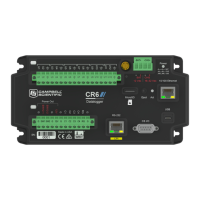Note: Per radio manufacturer instructions, do not use Frequency Key 14 (E) when using setting 1
(Australia), 3, or 4 (New Zealand). Refer to the FreeWave MM2-LV-T manual for more
information.
l Long data type
Where to find:
l Settings Editor tab in Device Configuration Utility: RF451 > Hop Table Version
10.4.74.11 RadioLowPwr
This setting allows a MultiPoint Slave to consume less power. When set to 2 through 31, the
transceiver will sleep between slots. For example, at a setting of 2 the transceiver sleeps 1 out of 2
slots; at a setting of 3 the transceiver sleeps 2 out of 3 slots...
The actual current draw depends on many factors. A low number reduces latency and a high
number reduces current consumption. An optimum setting (balancing latency and power
savings) is 2 or 3. The most significant benefit comes when changing from 0 to 2. To ensure
rigorous communications, make sure the RadioPacketRepeat setting is set on the Master Radio
(of the network) to a value at least as large as this value.
l Long data type
Where to find:
l Settings Editor tab in Device Configuration Utility: RF451 > Low Power Mode
10.4.74.12 RadioMaxPacket
Determines the maximum number of bytes in the packets. Throughput can be enhanced when
packet sizes are optimized. In Point-to-Point mode, the Max and Min Packet Settings will not
have material impact on throughput unless 115.2 KBaud is desired. However, this may have an
impact on latency.
For example, if small amounts of data is sent and large packet sizes are selected, there would be
a certain amount of time "wasted" between each packet. The default settings for Max packet size,
Min packet size and RF Data Rate are 8, 9, and Normal RF Data Rate, respectively. In MultiPoint
networks, the Max Packet Size and Min Packet Size must be set identically in all transceivers.
l Long data type
Where to find:
l Settings Editor tab in Device Configuration Utility: RF451 > MaxPacket Size
10. Information tables and settings (advanced) 197

